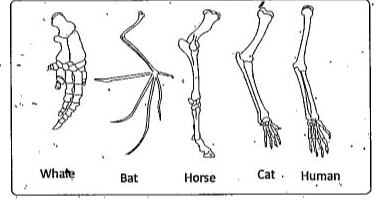Write a brief note on Morphological Evidences in favour of organic evolution .Solution in Telugu
Evidences from comparative anatomy : When we compare the anatomy of different animals, we find some similarities among them . For example, the fore limbs of different vertebrates are similar in origin and internal structure . All these indicate that there is a relationship among the organisms . These relationships can be studied under
i) Homologous organs,
ii) Analogous organs,
iii) Vestigial organs,
iv) Atavistic organs and
v) Connecting links .

i) Homologous organs : The organs which have similar structure and origin but not necessarily the same function are called homologous organs . The evolutionary pattern that describes the occurrence of similarity in origin and internal structure is called homology . Such organs show adaptive radiation, hence .divergent evolution. . e.g., the appendages of vertebrates such as the flippers of whale, wings of bat, forelimbs of horse, paw of cat and hand of man have a ommon pattern in the arrangement of bones even through their external form and function may vary to suit their mode of life . It explains that all the vertebrates might have had a common ancestor .
Analogous organs : The organs which have dissimilar structure and origin but perform the same function are called the analogous organs . Analogous organs suggest .convergent evolution., e.g., wings of a butterfly and wings of a bird .
iii) Vestigial organs : The organs which were functional in the ancestors but non-functional and reduced in the descendants are called vestigial organs . Presence of vestigial organs is the most convincing evidence in favour of organic evolution and also supports the concept of disuse proposed by Lamarck, e.g., Hind Limbs in python, hind limbs and pelvic girdle in whale, wings of flightless birds, vermiform appendix, coccyx, plica semilunaris (vestigial nictitating membrance ), auricular muscles that move the pinna, hair on the body , mammary glands in males, etc, in human beings :
iv) Atavistic organs : Sudden appearance of some vestigial organs in a better developed condition as in the case of the tailed human body is called atavism . Such organs are called atavistic organs . They strongly support the concept of organic evolution .
v) Connecting links : The organisms which possess the characters of two different gropus between which they are transitional are called connecting links . They clearly explain the path of evolution, e.g. Peripatus between annelida and arthropoda, prototherians between reptilia and mammalia, etc.
Topper's Solved these Questions
- BOOK - VGS PUBLICATION-BRILLIANTCHAPTER - ZOOLOGY MODEL PAPER 13EXERCISE - Section-C3videos
ZOOLOGY MODEL PAPER 13
- BOOK - VGS PUBLICATION-BRILLIANTCHAPTER - ZOOLOGY MODEL PAPER 13EXERCISE - Section-C3videos
ZOOLOGY MODEL PAPER 13
- BOOK - VGS PUBLICATION-BRILLIANTCHAPTER - MOST IMPORTANT QUESTIONSEXERCISE - UNIT -VIII APPLIED BIOLOGY ( SHORT ANSWER TYPE QUESTIONS)9videos
MOST IMPORTANT QUESTIONS
- BOOK - VGS PUBLICATION-BRILLIANTCHAPTER - ZOOLOGY MODEL PAPER 14EXERCISE - Section-C3videos
ZOOLOGY MODEL PAPER 14
Similar Questions
How does human heart function topump blood to the body parts ?
02:28View SolutionHow does human heart function topump blood to the body parts ?
03:07View SolutionList out the various steps involved in MOET."
04:54View SolutionDescribe the structure of the heart of man with the help of neat labelled diagram.
02:07View SolutionAn important evidence in favour of organic evolution is the occurrence of :
01:25View SolutionAn important evidence in favour of organic evolution is the occurrence of :
02:49View SolutionAn important evidence in favour of organic evolution is the occurrence of
View SolutionDescribe in brief the embryological evidences in support of organic evolution
03:07View SolutionAn important evidence in favour of organic evolution is the occurrence of
03:43View SolutionList three factors that provide evidences in favour of evolution in organisms and state the role of each in brief.
View SolutionPalaeontological evidence in favour of organic evolution is beautifully illustrated by
02:17View SolutionDescribe in brief the palaeontological evidences in support of organic evolution.
01:50View SolutionDescribe in brief the biogeographical evidences in support of organic evolution.
View SolutionAn important evidence in favour of organic evolution is the occurrence of
06:20View SolutionAn important evidence in favour of organic evolution is the occurrence of :
50:21View SolutionAn important evidence in favour of organic evolution is the occurrence of :
01:38View Solution

